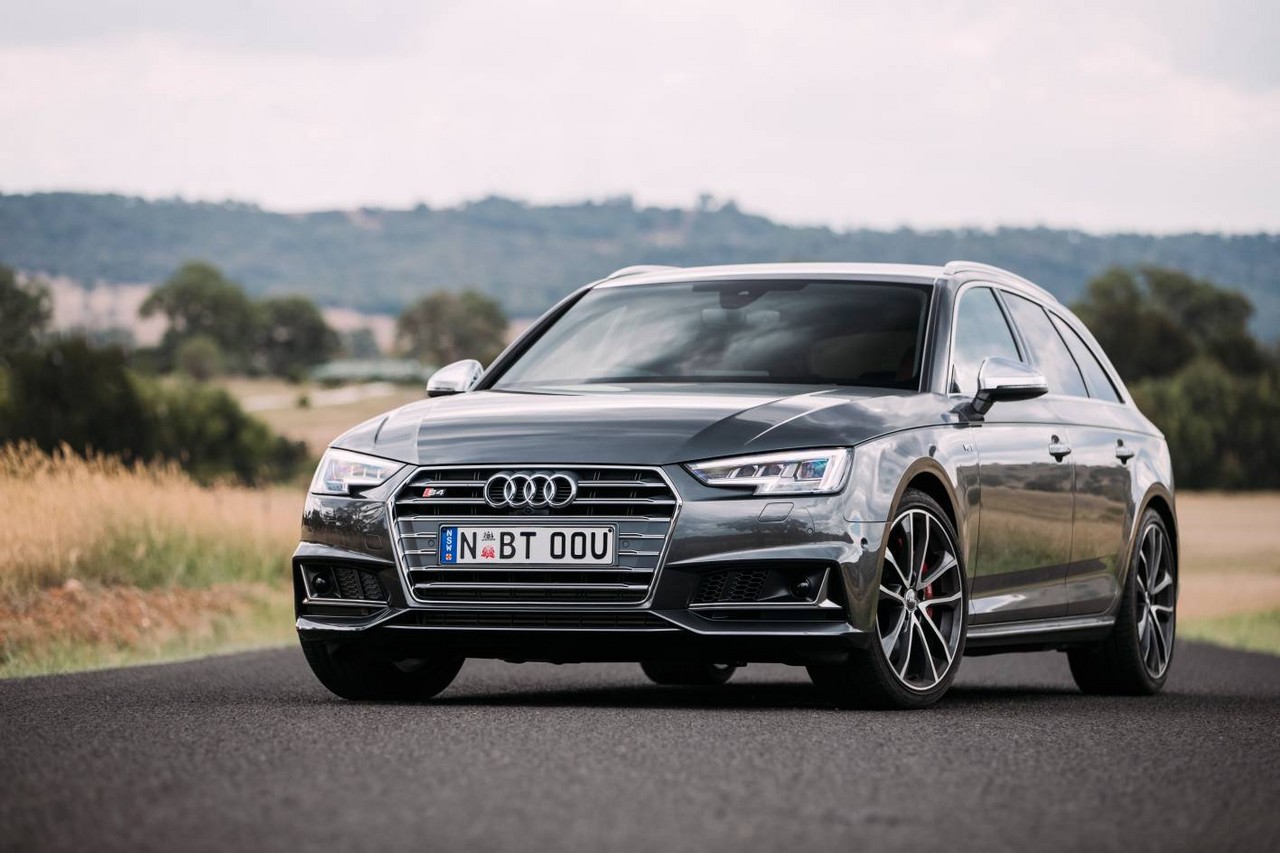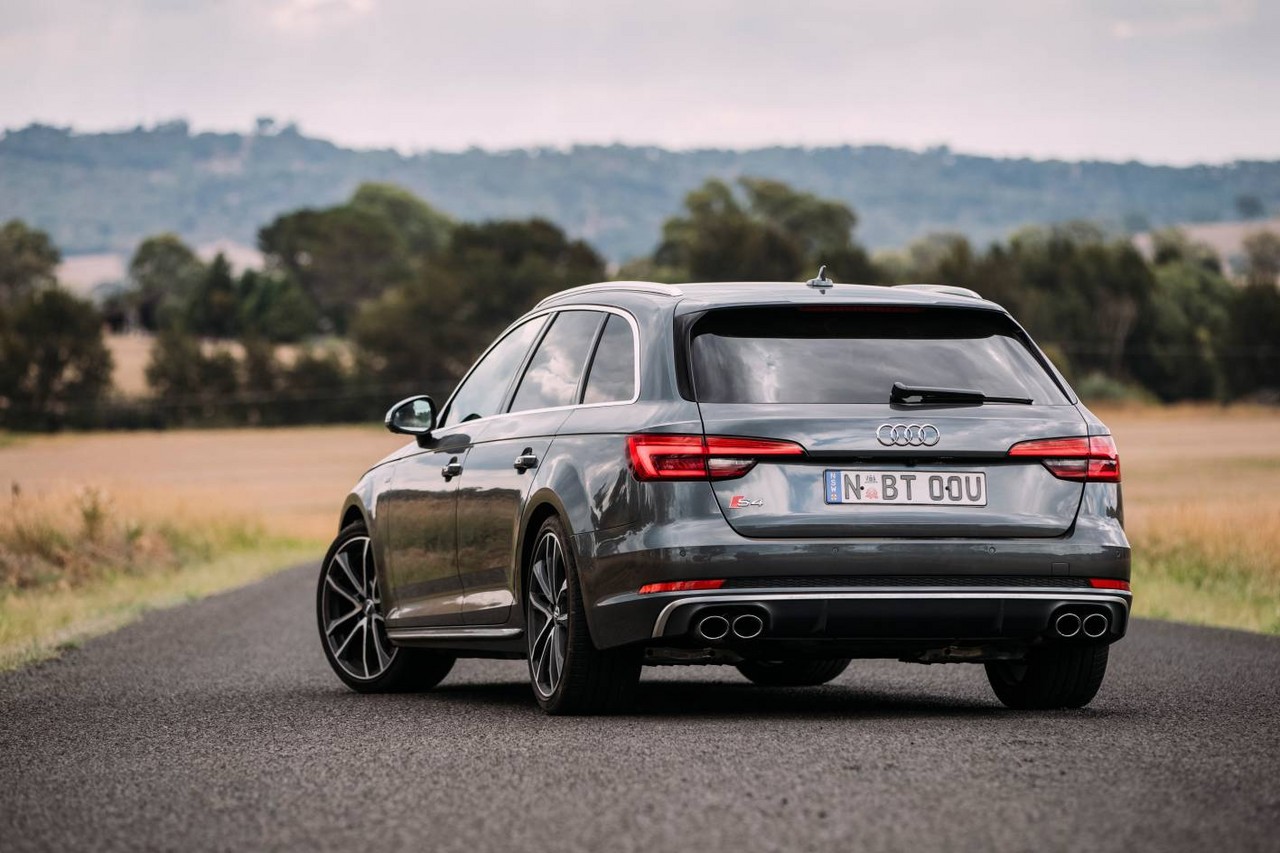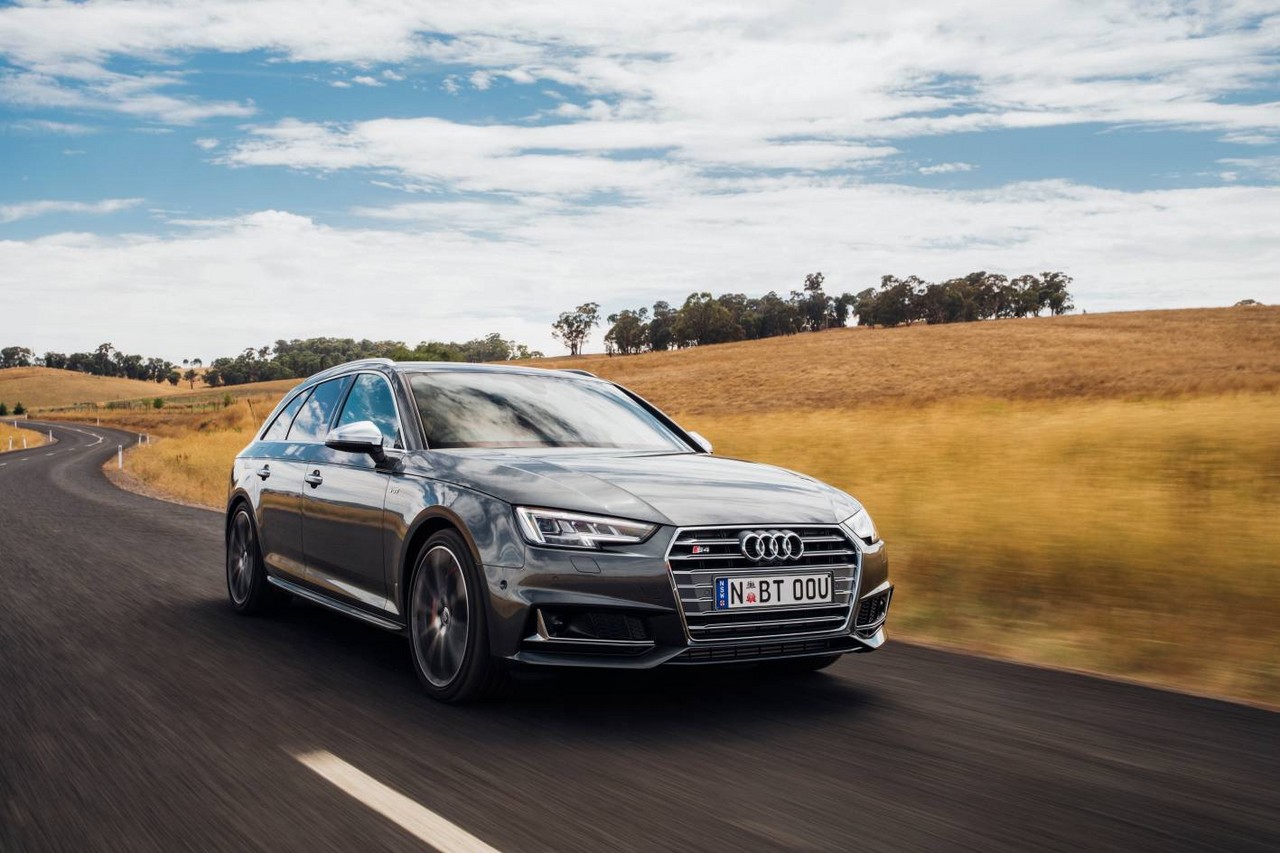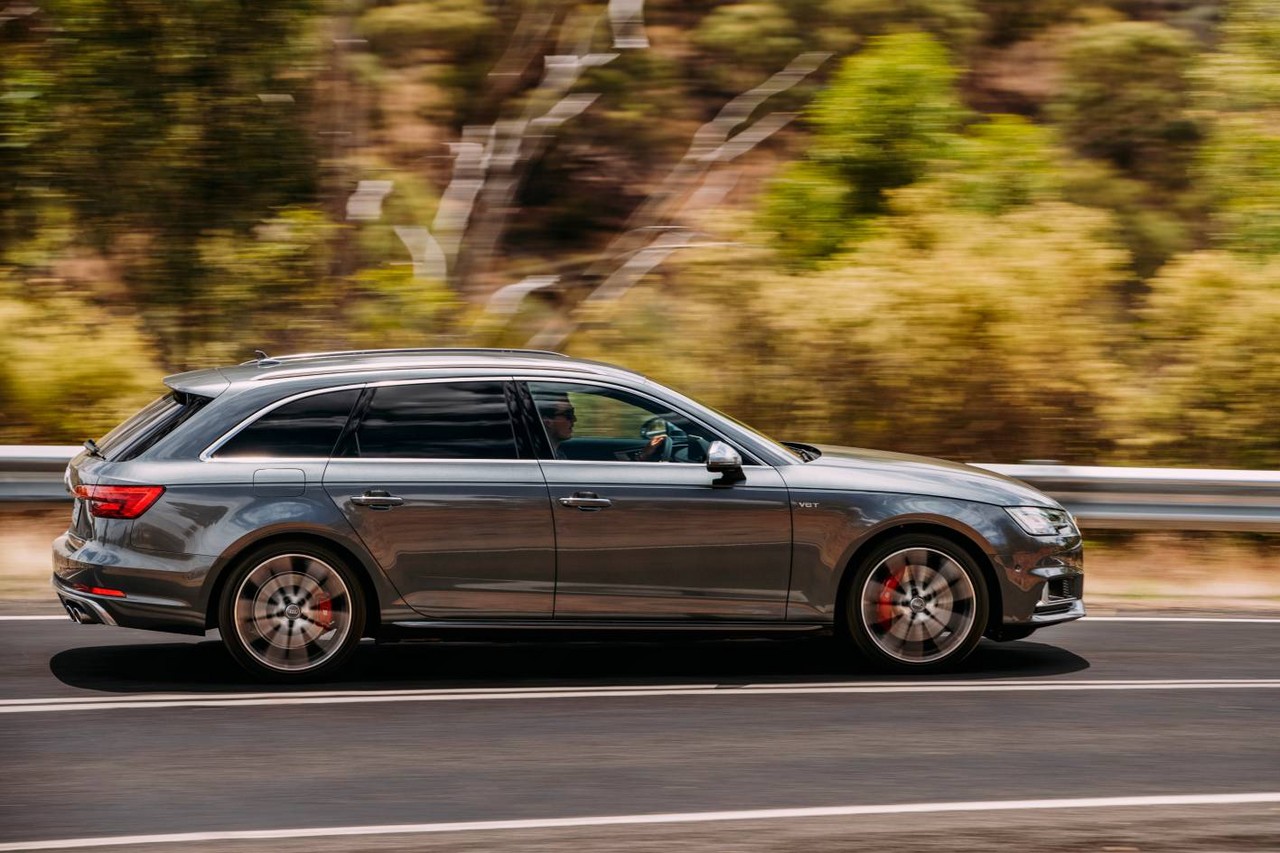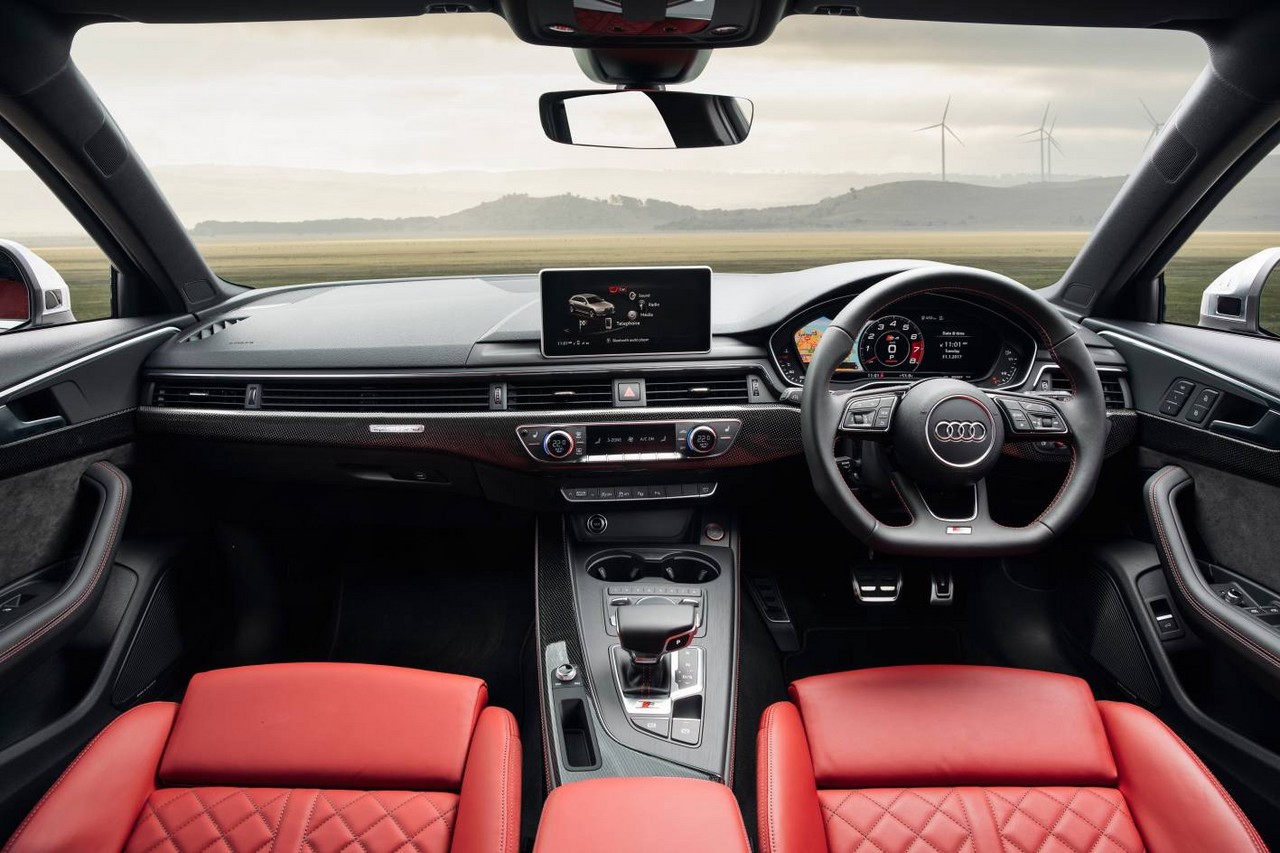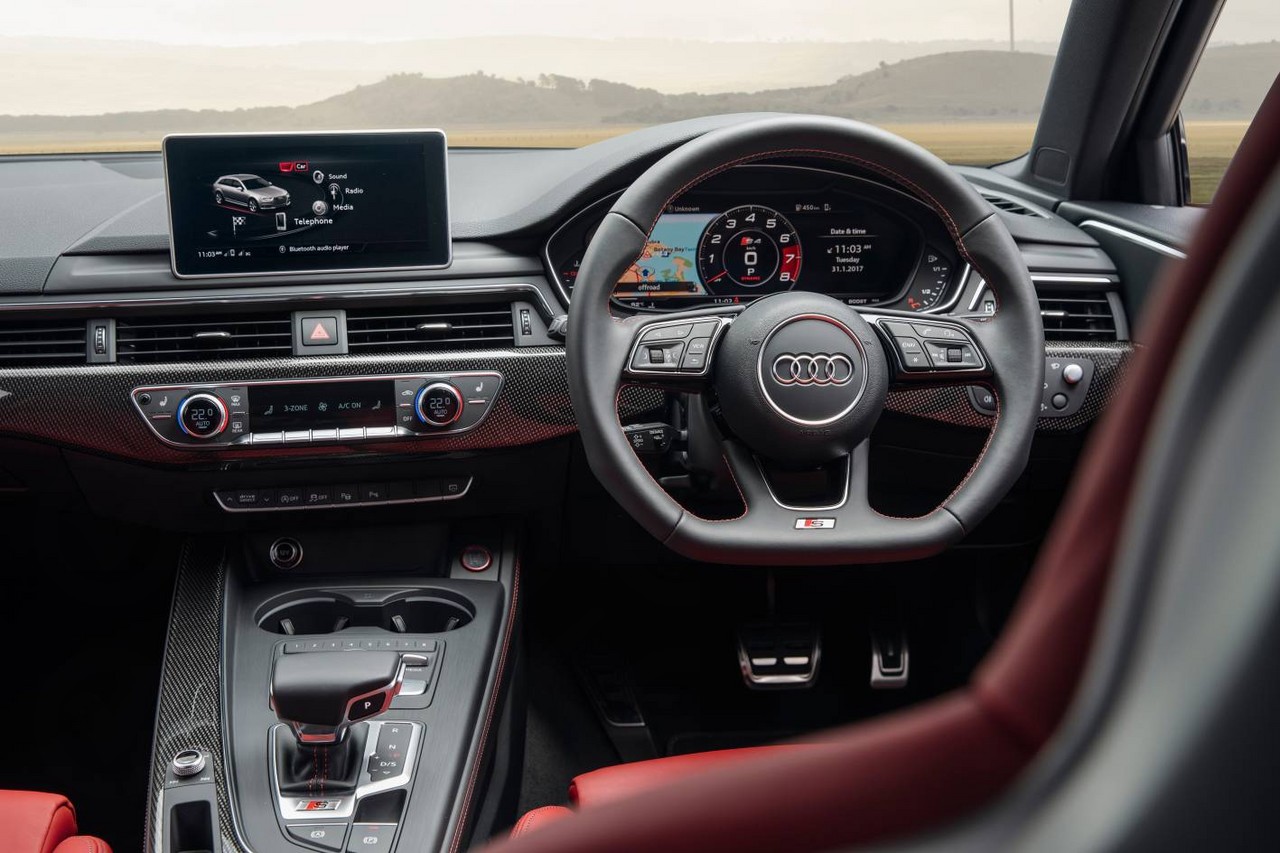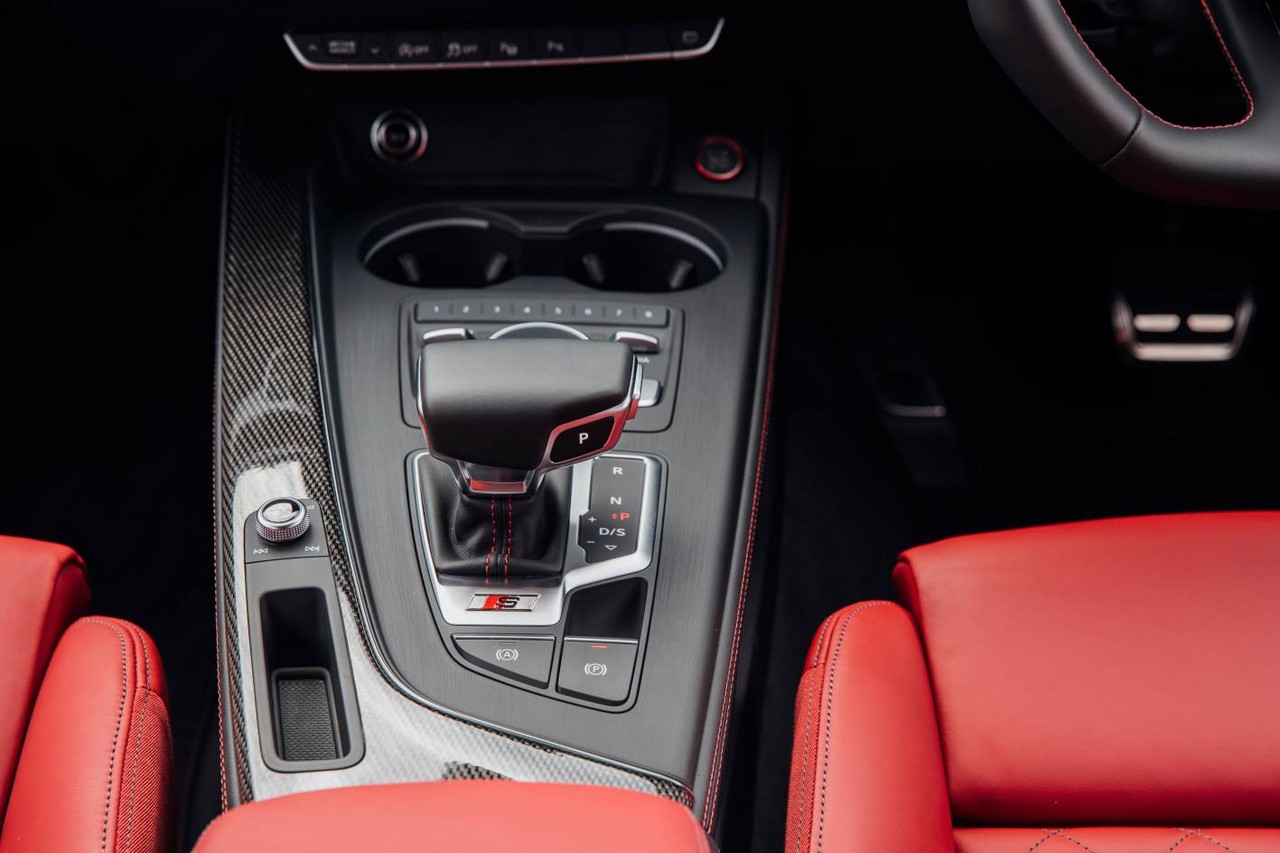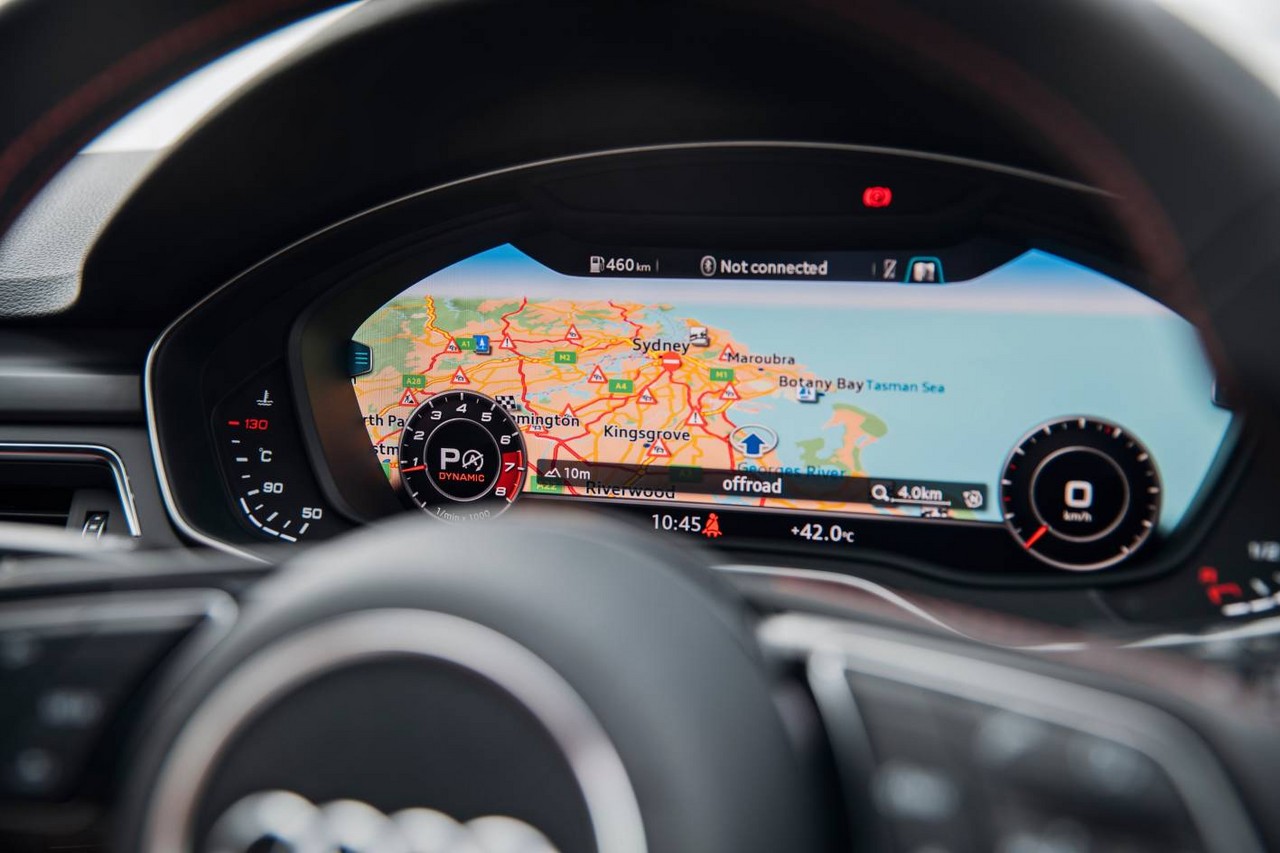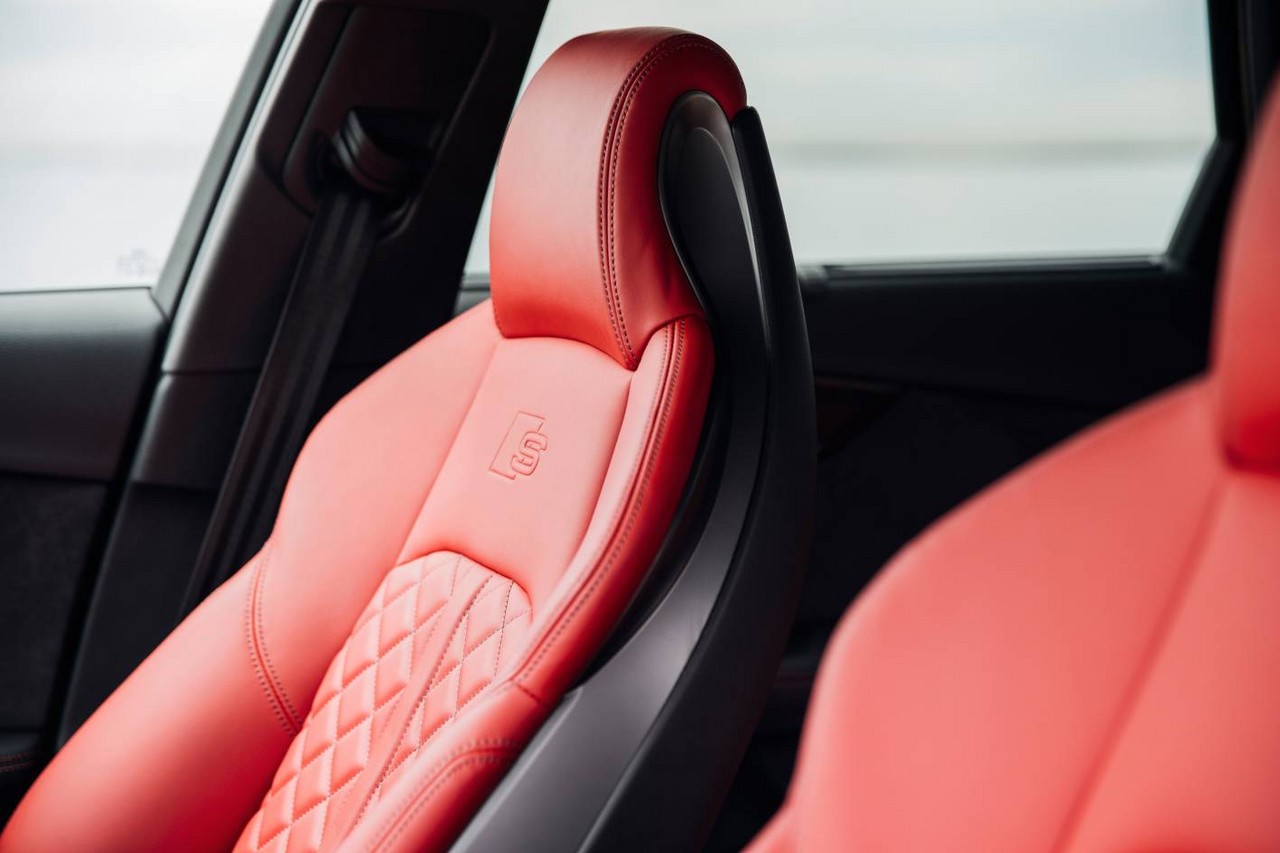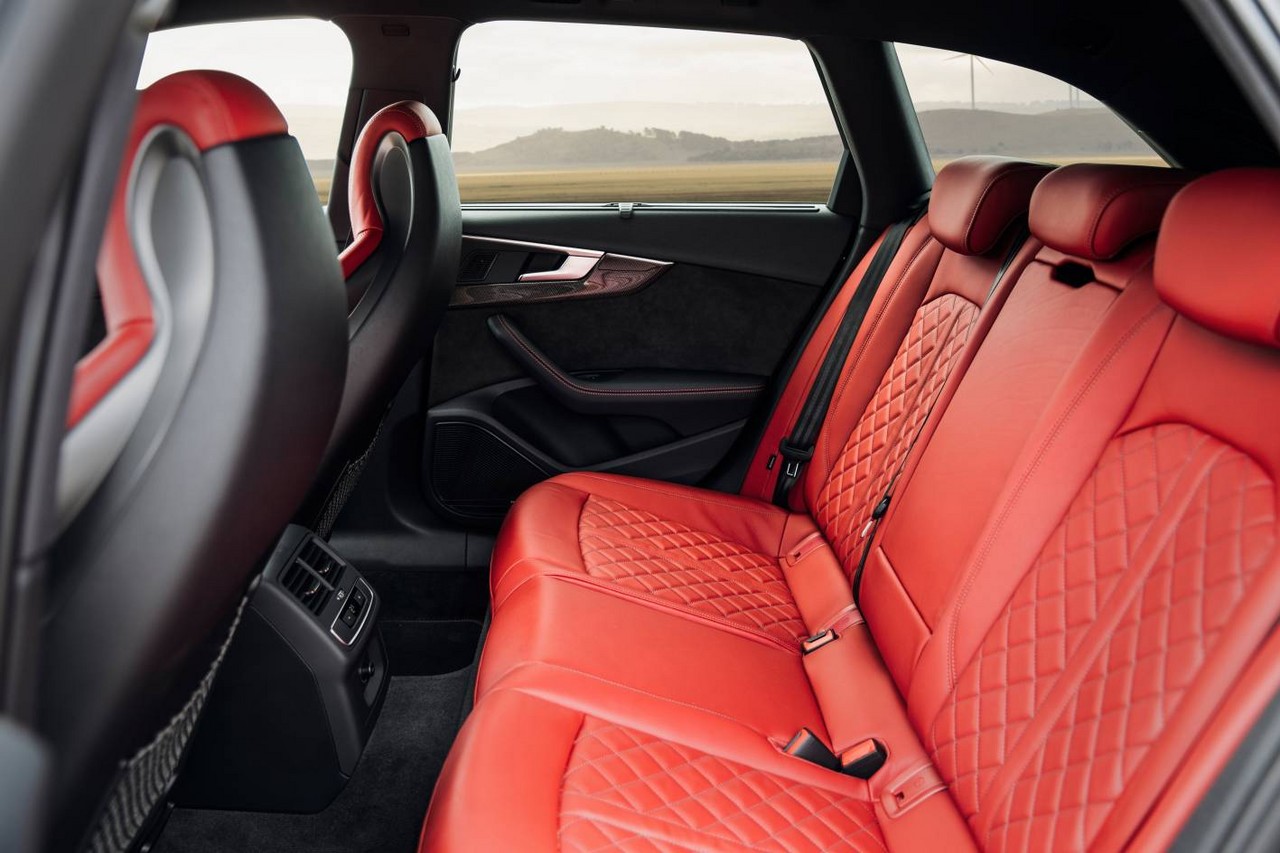
- Powerful 3.0-litre CWGD turbo V6 engine
- Adaptive dampers provide excellent ride & handling characteristics
- quattro system provides permanent AWD
- High standard of interior fit and finish
- Quiet, well-insulated cabin
- Steering lacks feel
- Satellite navigation system uses a rotary controller rather than touch screen
- Flat torque curve limits excitement as revs increase
- Familiar styling
Overview
Commencing production in November 2016 and officially released in Australia in February 2017, the Audi B9 S4 and S4 Avant were compact executive sedans and wagons, respectively. Manufactured in Ingolstadt, the four-wheel drive Audi B9 S4 was powered by a 3.0-litre direct-injection turbocharged V6 petrol engine that was mated to an eight-speed automatic transmission. As such, the Audi B9 S4 and S4 Avant could accelerate from rest to 100 km/h in 4.7 and 4.9 seconds, respectively; over the combined ADR 81/02 test cycle, fuel consumption was 7.7 and 7.8 litres per 100 km.
Audi B9 S4: CWGD engine
The Audi B8 S4’s CWGD V6 engine had 84.5 mm bores and an 89.0 mm stroke for a capacity of 2995 cc. Key features of the CWGD engine included its aluminium alloy crankcase and cylinder head, grey cast iron cylinder liners, four valves per cylinder, variable intake and exhaust valve timing, variable exhaust valve timing, twin-scroll turbocharger, direct injection and compression ratio of 11.2:1. To reduce fuel consumption, the CWGD engine had:
- A Start-Stop system which enabled it to shut down as the vehicle was coming to rest; and,
- A free-wheel function which disengaged the engine from the driveline to reduce engine braking at speeds between 55 km/h and 160 km/h.
To avoid knock (i.e. uncontrolled detonation), the CWGD had a shorter compression phase relative to the expansion phase. According to Audi, the variable valvelift system enabled short intake valve opening times of 130 crankshaft degrees under part loads while simultaneously closing the intake valves early. At higher loads, the inlet valves could be shifted over to a camshaft contour with a longer opening time and larger valve stroke that maximised engine power.
The CWGD engine complied with Euro 6 emissions standards.
| Engine | Trans. | Peak power | Peak torque | |
|---|---|---|---|---|
| Audi B9 S4 | 3.0-litre CWGD turbo petrol V6 | 8sp auto | 260 kW at 5400-6400 rpm | 500 Nm at 1370-4500 rpm |
quattro all-wheel drive
The four-wheel drive ‘quattro’ system for the Audi B9 S4 was a purely mechanical system which utilised a self-locking central differential (designed as a planetary gear train). In normal conditions, the differential provided 60 per cent of the engine’s torque to the rear axle and 40 per cent to the front, i.e. a 40:60 front:rear torque split. Depending on the situation, however, up to 70 per cent of the engine’s torque could be transferred to the front and up to 85 per cent to the rear.
When cornering, the wheels on the inside of the corner were slightly braked before they could slip; according to Audi, this provided more precise, agile and stable handling. As an extra-cost option, the Audi S4 was offered with a sport differential which actively distributed drive forces between the rear wheels.
Dimensions and body
Based on the Audi B9 A4 , the Audi B9 S4 was 4726 mm long, 1842 mm wide, 1429 mm tall and has a 2822 mm long wheelbase. The B9 S4 Avant, however, was 19 mm longer (at 4745 mm), 34 mm lower (1395 mm) and has a 9 mm longer wheelbase (2831 mm). The Audi B9 S4 and S4 Avant had unladen weights of 1735 kg and 1810 kg, respectively. Boot capacity for the S4 sedan is 480 litres, while the S4 Avant had cargo capacity of 505 litres which increased to 1510 litres when the rear seats were folded.
Compared to the Audi B9 A4 , the Audi B9 S4 could be identified by its ‘aluminium look’ door mirror housings, strongly profiled sill trims, separating edge for the tailgate, S-specific rear bumper with black honeycomb grille, S-typical diffuser clip and four tailpipes for the dual-branch exhaust system.
Suspension
The Audi B9 S4 had five-link front suspension in which the upper links and integrated into the bodywork and the lower links are attached with rubber mounts to a hybrid steel/aluminium sub-frame. For the five-link rear suspension, the axle was insulated from the body by hydraulically damped axle mounts. To reduce mass, the axle links, pivot bearings and dampers stilts were made of forged aluminium. Compared to the B9 A4 , the standard S sport suspension was 23 mm lower.
As standard, the Audi B9 S4 had ‘Continuous Damping Control’ (CDC) shock absorbers which featured electromagnetically controlled valves in their pistons to control the flow of hydraulic fluid. For the CDC system, the central suspension control unit processed inputs from sensors measuring movement and acceleration (longitudinal and transverse) to control each shock absorbed individually; the driver could also adjust their behaviour by selecting from several modes.
Steering
The Audi B9 A4 had electromechanical power steering. As an extra-cost option, the B9 S4 was available with speed-dependent ‘dynamic steering’ which varies its ratio – by up to 100 per cent – according to the vehicle’s speed, steering angle and drive mode selected.
Safety equipment
Standard safety equipment for the Audi B9 S4 included dual front airbags, front rear side airbags, full-length curtain airbags (i.e. for front and rear occupants), ABS, electronic brake force distribution, brake assist, electronic stability control, traction control and front seatbelts with pre-tensioners and load limiters.
As standard, the Audi B9 S4 was fitted with ‘Audi pre sense city’. Operating at speeds up to 85 km/h, Audi pre sense city used a windscreen-mounted front camera to scan the road for other vehicles and pedestrians. If there was a risk of a collision, the driver would receive a series of warnings and, if the driver failed to respond, full braking force would be applied autonomously. At initial speeds of up to 40 km/h, collisions can be prevented; at higher speeds (up to 85 km/h), the severity of the collision would be reduced.
An extension of ‘Audi pre sense city’, the ‘Audi pre sense front’ system could prevent front-to-rear collisions or reduce their severity. In hazardous situations, the driver would receive warnings visual and acoustic warnings to apply the brakes, followed by a brief application of the brakes for a jolting effect to alert the driver. If the driver fails to respond, the S4 would decelerate to the greatest possible extent if the vehicle ahead of it is still moving.
Also fitted as standard, ‘Audi pre sense rear’ can warn of potential collisions from behind, warn following traffic by rapidly flashing the brake lights and activate the ‘Audi pre sense basic’ protection measures such as tightening the front seatbelts, and closing the windows and sunroof (where fitted).
The Audi B9 S4 was also fitted with the following active safety technologies –
- Adaptive Cruise Control (ACC): using two front radar sensors and the camera, ACC could maintain a specified distance – from five distances – between the S4 and the vehicle ahead. Furthermore, ‘Audi drive select’ could be used to adjust the rate of acceleration and other control dynamics;
- Stop&Go function: an extension of the, ‘Stop&Go’ operated at speeds of 60 km/h to apply the brakes and bring the vehicle to rest. Once traffic began moving, the Audi S4 would automatically accelerate;
- Traffic-jam assist: an extension of the ACC, traffic-jam assist function could take control of steering operations at speeds up to 65 km/h on ‘well-developed roads when traffic is congested.’ In doing so, traffic-jam assist used the lane markings and other vehicles on the road for orientation. When the traffic-jam assist function reached its limits – for example, when traffic is sparse or there is a sharp corner ahead – the driver had to take over steering. Hence, the system provided warnings at different levels;
- Predictive efficiency assistant: used navigation data to keep the driver informed about situations which required lower speed, such as corners, roundabouts, road junctions, gradients, city limits and speed limit signs. A corresponding alert would appear in the instrument cluster and/or Audi virtual cockpit and head-up display. For models with automatic transmissions, the system could also take over freewheeling of the automatic transmission in certain conditions;
- Avoidance assist: activated when the Audi S4 needed to avoid an obstacle to avert a collision. Using data from the front camera, the ACC and radar sensors, ‘avoidance assist’ could calculate the distance of the car ahead, its width and degree of offset. The brakes would be briefly applied to alert the driver of the potential danger and, once the driver started steering, the system would provide ‘support with the necessary lane changes with controlled interventions to the power steering’;
- Turning assist: active at speeds from 2 km/h to 10 km/h, ‘Turning assist’ could monitor oncoming traffic during right turns (for cars with right-hand drive). In hazardous situations, the brakes could be applied to bring the vehicle to rest. Turning assist operated once the driver activated the right-hand turn signal;
- Audi active lane assist: used the front camera to detect lane markings at speeds of 65 km/h and above. If the Audi S4 approached a lane marking without the driver having previously indicated, the electromechanical steering could provide an adjustment to bring the vehicle back into its lane. Using the MMI system, the driver could determine whether this system should be activated at all times or only before the lane marking is crossed. As an option, the driver could choose to have steering wheel vibrations as a warning signal;
- Audi side assist: operating at speeds above 15 km/h, Audi side assist used the two rear radar sensors to monitor traffic up to 70 metres behind the Audi S4. If another vehicle approached quickly or was in the driver’s blind spot, a warning LED in the housing of the appropriate door mirror would illuminate. If the driver activated the indicator to change lanes, the LED would blink rapidly to warn the driver;
- Rear cross-traffic assist: when reversing at low speeds, rear cross-traffic assist used the rear radar sensors to detect approaching traffic. If approaching traffic was detected which may cross the vehicle’s path, the driver received warnings (visual, acoustic and a brief, jolting application of the brakes);
- Exit warning: activated when the vehicle stopped moving and could warn occupants if vehicles were approaching from behind by illuminating red fibre optics in the door-opening mechanism as the doors were opened; and,
- Attention assist: monitored driver behaviour and issued a warning if the driver was assessed to be ‘inattentive’.
Brakes
The Audi S4 had 350 mm by 34 mm ventilated front disc brakes with six-piston fixed callipers and 330 mm by 22 mm ventilated rear disc brakes.
Features: Audi B9 S4
Standard features for the Audi B9 S4 included a 180 watt Audi sound system with ten speakers and a six-channel amplifier, digital radio tuner (DAB+), Audi music interface via USB including Audi smartphone interface, Bluetooth mobile phone connectivity and audio streaming, ‘Audi connect’ with in-car Wi-Fi hotspot and Google services, and Audi’s ‘MMI navigation plus’ system which consisted of an 8.3-inch colour display and a seven-inch instrument cluster display, live traffic updates, voice control, CD/DVD player, auxiliary inputs, two SDXC card readers and 10 GB flash memory. Furthermore, the ‘Audi smartphone interface’ could connect Apple or Android mobile devices via USB to approved apps via the MMI interface.
The Audi B9 S4 was also equipped with 8.5J x 19-inch ‘Audi Sport’ alloy wheels with 245/35 R19 tyres, power adjustable and heated front sports seats, combination leather and Alcantara seat upholstery, three-zone climate control air conditioning, LED headlights with LED daytime running lights, dusk-sensing headlights, high beam assist, rain-sensing wipers, a surround view camera system, 40:20:40 split and folding rear seats, a leather-wrapped steering wheel with gearshift paddles, remote central locking with proximity key, power adjustable and heated door mirrors with auto-dimming and folding function, power windows, driver’s seat memory settings, an auto-dimming interior mirror, a height and reach adjustable steering wheel, push-button start, ambient lighting, illuminated door sills, floor mats (front and rear), rear privacy glass, tyre pressure monitoring, a trip computer and an immobiliser.
As standard, the Audi S4 was also equipped with the following features –
- ‘Audi Virtual cockpit’: a fully configurable 12.3-inch high resolution display within the instrument cluster;
- Audi parking system plus: front and rear parking sensors and a visual display; and,
- Park assist: provided automated steering for parallel or perpendicular parking manoeuvres.
Features: Audi B9 S4 Avant
The Audi B9 S4 Avant was further equipped with anodised aluminium roof rails, a power-operated tailgate, power-retracting luggage cover, a sensor-controlled luggage compartment release and an extendable partition net for the luggage compartment.
Brochure and specifications
- Brochure: Audi B9 S4 (February 2017)
- Specifications: Audi B9 S4 Sedan (February 2017)
- Specifications: Audi B9 S4 Avant (February 2017)
